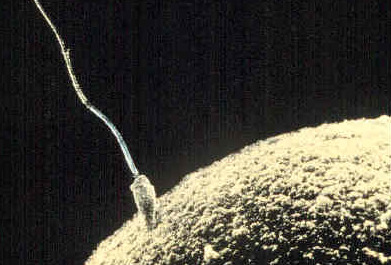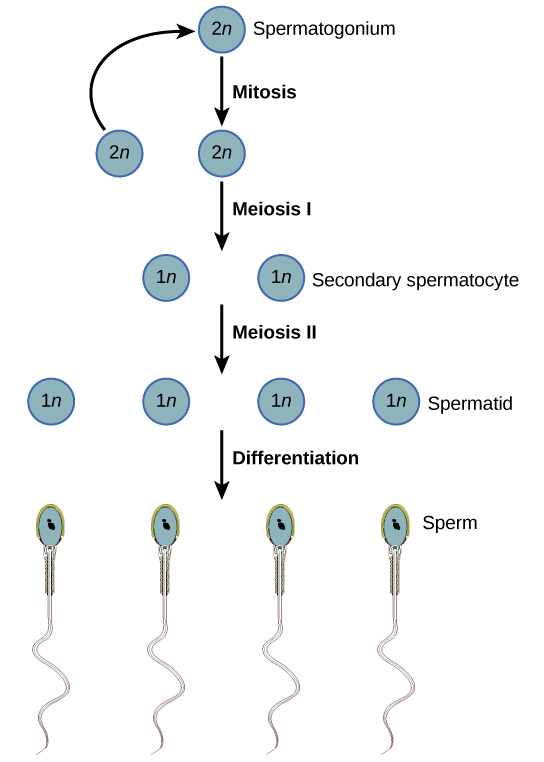Meiosis and Sexual Reproduction 21-1 Meiosis Vocabulary Review Croosward
seven.5: Sexual Reproduction: Meiosis and gametogenesis
- Page ID
- 16757
The family photo in Figure \(\PageIndex{1}\) illustrates an important betoken. Children in a family resemble their parents and each other, just the children are never exactly the same unless they are identical twins. Each of the children in the photo inherited a unique combination of traits from the parents. In this concept, y'all will learn how this happens. It all begins with sex activity — sexual reproduction, that is.

Sexual Reproduction
Why do you look similar to your parents, but non identical? First, it is because you have two parents. Second, it is considering of sexual reproduction. Whereas asexual reproduction produces genetically identical clones, sexual reproduction produces genetically various individuals. Sexual reproduction is the creation of a new organism past combining the genetic material of two organisms. As both parents contribute half of the new organism's genetic textile, the offspring will accept traits of both parents, but will non be exactly like either parent.
Organisms that reproduce sexually by joining gametes, a process known as fertilization, must have a mechanism to produce haploid gametes. This mechanism is meiosis, a blazon of cell partitioning that halves the number of chromosomes. During meiosis, the pairs of chromosomes separate and segregate randomly to produce gametes with one chromosome from each pair. Meiosis involves two nuclear and jail cell divisions without interphase in between, starting with one diploid cell and generating iv haploid cells. Each division, named meiosis I and meiosis Ii, has iv stages: prophase, metaphase, anaphase, and telophase. These stages are similar to those of mitosis, but there are singled-out and of import differences.
Prior to meiosis, the cell's Dna is replicated, generating chromosomes with two sister chromatids. A human cell prior to meiosis will have 46 chromosomes, 22 pairs of homologous autosomes, and 1 pair of sex chromosomes. Homologous chromosomes (Effigy \(\PageIndex{2}\)), or homologs, are similar in size, shape, and genetic content; they contain the same genes, though they may have dissimilar alleles of those genes. The genes/alleles are at the same loci on homologous chromosomes. You inherit one chromosome of each pair of homologs from your mother and the other one from your father. Sexual reproduction is the chief method of reproduction for the vast majority of multicellular organisms, including most all animals and plants. Fertilization joins two haploid gametes into a diploid zygote, the kickoff cell of a new organism. The zygote enters G1 of the first cell bike, and the organism begins to grow and develop through mitosis and cell division.
Meiosis

The process that produces haploid gametes is chosen meiosis. Meiosis is a type of prison cell division in which the number of chromosomes is reduced past one-half. It occurs only in certain special cells of an organism. In mammals, Meiosis occurs merely in gamete producing cells within the gonads. During meiosis, homologous (paired) chromosomes separate, and haploid cells course that have only one chromosome from each pair. Figure \(\PageIndex{3}\) gives an overview of meiosis.
As you tin can encounter from the meiosis diagram, two cell divisions occur during the overall process, so a total of four haploid cells are produced. The two cell divisions are called meiosis I and meiosis Two. Meiosis I begins later Deoxyribonucleic acid replicates during interphase. Meiosis Two follows meiosis I without Dna replicating once more. Both meiosis I and meiosis 2 occur in four phases, called prophase, metaphase, anaphase, and telophase. You lot may recognize these four phases from mitosis, the division of the nucleus that takes place during routine prison cell division of eukaryotic cells.

Meiosis I
- Prophase I: The nuclear envelope begins to break down, and the chromosomes condense. Centrioles start moving to opposite poles of the jail cell, and a spindle begins to form. Importantly, homologous chromosomes pair up, which is unique to prophase I. In prophase of mitosis and meiosis II, homologous chromosomes do not form pairs in this style. During prophase I, crossing-over occurs. The significance of crossing-over is discussed in the side by side section called variations.
- Metaphase I: Spindle fibers attach to the paired homologous chromosomes. The paired chromosomes line up forth the equator of the prison cell. This occurs only in metaphase I. In metaphase of mitosis and meiosis Ii, it is sister chromatids that line up along the equator of the cell.
- Anaphase I: Spindle fibers shorten, and the chromosomes of each homologous pair start to separate from each other. One chromosome of each pair moves toward i pole of the cell, and the other chromosome moves toward the opposite pole.
- Telophase I and Cytokinesis: The spindle breaks down, and new nuclear membranes form. The cytoplasm of the cell divides, and ii haploid daughter cells consequence. The daughter cells each have a random array of chromosomes, with one from each homologous pair. Both daughter cells continue to meiosis Ii.
Meiosis II
- Prophase II: The nuclear envelope breaks down and the spindle begins to course in each haploid daughter cell from meiosis I. The centrioles also starting time to separate.
- Metaphase II: Spindle fibers line upwardly the sister chromatids of each chromosome forth the equator of the cell.
- Anaphase Two: Sister chromatids separate and movement to opposite poles.
- Telophase Two and Cytokinesis: The spindle breaks down, and new nuclear membranes class. The cytoplasm of each prison cell divides, and four haploid cells result. Each cell has a unique combination of chromosomes.
Gametogenesis

At the end of meiosis, four haploid cells have been produced, but the cells are not notwithstanding gametes. The cells need to develop earlier they get mature gametes capable of fertilization. The evolution of diploid cells into gametes is called gametogenesis. Information technology differs betwixt males and females.
- A gamete produced by a male is chosen a sperm, and the process that produces a mature sperm is called spermatogenesis. During this process, a sperm jail cell grows a tail and gains the ability to "swim," like the human sperm cell shown in the figure below.
- A gamete produced past a female is called an egg, and the procedure that produces a mature egg is called oogenesis. Just one egg is produced from the four haploid cells that event from meiosis. The single egg is a very big cell, as you can see from the human egg also shown in Figure \(\PageIndex{v}\).
Spermatogenesis
Spermatogenesis occurs in the wall of the seminiferous tubules, with stalk cells at the periphery of the tube and the spermatozoa at the lumen of the tube. Immediately under the capsule of the tubule are diploid, undifferentiated cells. These stem cells, called spermatogonia (singular: spermatagonium), go through mitosis with one offspring going on to differentiate into a sperm cell, while the other gives ascension to the adjacent generation of sperm.

Effigy \(\PageIndex{half-dozen}\): Spermatogenesis During spermatogenesis, iv sperm result from each primary spermatocyte, which divides into ii haploid secondary spermatocytes; these cells volition go through a second meiotic division to produce four spermatids.
Meiosis begins with a jail cell called a main spermatocyte. At the end of the first meiotic sectionalisation, a haploid cell is produced called a secondary spermatocyte. This haploid cell must become through some other meiotic cell sectionalisation. The prison cell produced at the end of meiosis is called a spermatid. When it reaches the lumen of the tubule and grows a flagellum (or "tail"), information technology is called a sperm cell. Four sperm consequence from each primary spermatocyte that goes through meiosis.
Stem cells are deposited during gestation and are present at birth through the beginning of boyhood simply in an inactive state. During boyhood, gonadotropic hormones from the anterior pituitary cause the activation of these cells and the production of viable sperm. This continues into old historic period.
Oogenesis
Oogenesis occurs in the outermost layers of the ovaries. As with sperm production, oogenesis starts with a germ cell, chosen an oogonium (plural: oogonia), but this cell undergoes mitosis to increment in number, somewhen resulting in up to one to 2 million cells in the embryo.

The cell starting meiosis is chosen a chief oocyte. This cell will brainstorm the first meiotic division, merely be arrested in its progress in the first prophase stage. At the time of birth, all futurity eggs are in the prophase stage. At adolescence, anterior pituitary hormones crusade the development of a number of follicles in an ovary. This results in the principal oocyte finishing the first meiotic division. The cell divides unequally, with most of the cellular fabric and organelles going to ane prison cell, called a secondary oocyte, and only one set of chromosomes and a small amount of cytoplasm going to the other cell. This second cell is called a polar body and ordinarily dies. A secondary meiotic arrest occurs, this time at the metaphase II stage. At ovulation, this secondary oocyte will exist released and travel toward the uterus through the oviduct. If the secondary oocyte is fertilized, the cell continues through the meiosis 2, completing meiosis, producing a second polar trunk and a fertilized egg containing all 46 chromosomes of a man being, half of them coming from the sperm.
Review
- Explain how sexual reproduction occurs at the cellular level.
- Summarize what happens during meiosis.
- Compare and dissimilarity gametogenesis in males and females.
- Explicate mechanisms that increase genetic variation in offspring produced by sexual reproduction.
- Why do gametes need to be haploid? What would happen to the chromosome number after fertilization if they were diploid?
- Depict i deviation between prophase I of meiosis and prophase of mitosis.
- Do all of the chromosomes that yous got from your female parent go into one of your gametes? Why or why not?
- True or False . Crossing-over is the exchange of genetic fabric between sister chromatids.
- True or False . Human sperms are haploid.
- True or Faux . Sister chromatids separate from each other during meiosis I.
- How many cells are produced after a unmarried cell goes through meiosis?
- Which stage of meiosis (prophase I or Two; metaphase I or II; anaphase I or II; telophase I or II) best fits the descriptions below? Choose only one for each description.
- Pairs of homologous chromosomes line upward along the equator of the prison cell
- Sister chromatids separate
- Homologous chromosomes separate from each other
Explore More
rutherfordsudight.blogspot.com
Source: https://bio.libretexts.org/Bookshelves/Human_Biology/Book:_Human_Biology_%28Wakim_and_Grewal%29/07:_Cell_Reproduction/7.5:_Sexual_Reproduction:_Meiosis_and_gametogenesis
Post a Comment for "Meiosis and Sexual Reproduction 21-1 Meiosis Vocabulary Review Croosward"